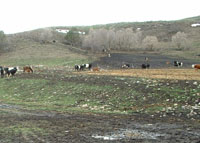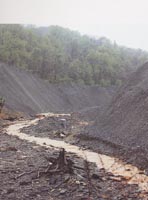UPCOMING EVENTS
View full calendarNon-Point Source
What is Non-Point Source (NPS)? 
Examples of NPS
| Non-Point Source | Pollutant |
| Urban Runoff | Oil, Grease, Toxic chemicals, Nutrients |
| Poorly Managed Construction Sites | Sediment |
| Irrigation Practices | Salt |
| Abandoned Mines | Acid drainage |
| Livestock Operations, Pet and Human Wastes, and Faulty Septic Systems | Bacteria, Nutrients |
Effects of NPS Pollution
 Nonpoint source pollution is the leading cause of water quality problems according
to many states. Excess nutrients (such as nitrogen and phosphorus) from agricultural
land uses like fertilizing, concentrated animal feeding operations, and pesticide
spraying may run off into streams and rivers. This increase in nutrients may overstimulate
growth of aquatic plants like algae. Although plants give off oxygen when they are
alive, during decomposition dissolved oxygen is consumed. This can harm aquatic life like fish and insects that need dissolved
oxygen to survive.
Nonpoint source pollution is the leading cause of water quality problems according
to many states. Excess nutrients (such as nitrogen and phosphorus) from agricultural
land uses like fertilizing, concentrated animal feeding operations, and pesticide
spraying may run off into streams and rivers. This increase in nutrients may overstimulate
growth of aquatic plants like algae. Although plants give off oxygen when they are
alive, during decomposition dissolved oxygen is consumed. This can harm aquatic life like fish and insects that need dissolved
oxygen to survive.
 Construction or logging efforts can cause a significant increase of sediment in nearby
waterways. The removal of vegetation exposes soil and without vegetation to take-up
water there is a greater erosion potential. Suspended solids (turbidity) from erosion prevents sunlight from reaching aquatic plants. Without light photosynthesis
cannot take place, which may reduce the amount of dissolved oxygen in the water. Dissolved oxygen is vital for fish and other aquatic life. Sediment
absorbs heat, so if there are a lot of suspended sediments the temperature of the surface water can rise. Turbidity can also make it hard for fish to see their
prey. Heavy loads of suspended solids can even clog fish gills and filter-feeding
devices of aquatic macroinvertebrates (water bugs). As solid matter settles, it may
cover and harm plants and animals and spawning beds.
Construction or logging efforts can cause a significant increase of sediment in nearby
waterways. The removal of vegetation exposes soil and without vegetation to take-up
water there is a greater erosion potential. Suspended solids (turbidity) from erosion prevents sunlight from reaching aquatic plants. Without light photosynthesis
cannot take place, which may reduce the amount of dissolved oxygen in the water. Dissolved oxygen is vital for fish and other aquatic life. Sediment
absorbs heat, so if there are a lot of suspended sediments the temperature of the surface water can rise. Turbidity can also make it hard for fish to see their
prey. Heavy loads of suspended solids can even clog fish gills and filter-feeding
devices of aquatic macroinvertebrates (water bugs). As solid matter settles, it may
cover and harm plants and animals and spawning beds.
 Drainage or runoff from abandoned mines may also contribute to nonpoint source pollution.
If air, water, and sulfur-containing rocks mix, chemical reactions can lead to the
formation of sulfuric acid and iron hydroxide. This acid runoff dissolves certain
heavy metals (e.g., copper, lead, and mercury) which contaminate waterways. Acid mine
drainage can also affect the pH of water. Water with an extremely high or low pH is deadly. Water with relatively
low pH (acidic) may reduce the hatching success of fish eggs, irritate fish and aquatic
insect gills, and damage membranes.
Drainage or runoff from abandoned mines may also contribute to nonpoint source pollution.
If air, water, and sulfur-containing rocks mix, chemical reactions can lead to the
formation of sulfuric acid and iron hydroxide. This acid runoff dissolves certain
heavy metals (e.g., copper, lead, and mercury) which contaminate waterways. Acid mine
drainage can also affect the pH of water. Water with an extremely high or low pH is deadly. Water with relatively
low pH (acidic) may reduce the hatching success of fish eggs, irritate fish and aquatic
insect gills, and damage membranes.
